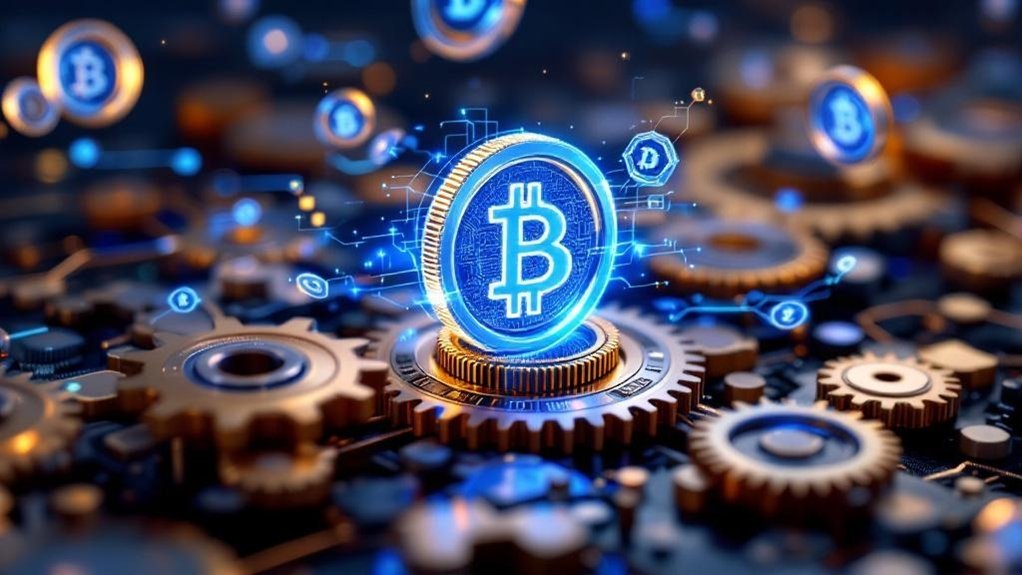Tokenomics powers the entire crypto ecosystem, combining token supply mechanics with economic incentives. It’s basically the rules of the game – how many tokens exist, who gets them, and what people can actually do with them. Smart projects create genuine utility and carefully balance inflation with deflation. Without solid tokenomics, a crypto project is just worthless digital confetti. The best projects nail this delicate dance between rewarding users and maintaining value. There’s way more to this story than meets the eye.

The world of cryptocurrency runs on tokenomics – the economic engine that powers every digital token in existence. It’s a fancy term that combines “token” and “economics,” serving as the backbone of how crypto projects manage their financial ecosystems.
Every serious blockchain project needs a solid tokenomics model, typically outlined in their whitepaper. Without it, they’re just another coin in the crypto sea. Understanding tokenomics helps investors evaluate a token’s long-term viability and potential returns. Projects often use decentralized autonomous organizations to govern their tokenomics.
Token supply is where things get interesting. There’s maximum supply – the total number of tokens that will ever exist – and circulating supply, which is what’s actually trading in the market right now.
Projects love to hoard tokens for different purposes: team rewards, marketing budgets, and those ever-important “ecosystem incentives.” Some tokens keep printing new coins through mining or staking, while others stick to a fixed supply. Transaction costs often include gas fees that compensate network validators for processing operations.
It’s like watching a digital economy experiment in real-time.
The utility factor is what separates the winners from the losers. A token needs to actually do something useful – whether it’s governance voting, paying for services, or accessing specific platform features.
Without utility, it’s just another worthless digital asset. Smart projects create multiple reasons for people to hold and use their tokens. They’re not just trying to pump the price; they’re building a functional ecosystem.
Demand drivers are the secret sauce in tokenomics. Projects dangle carrots like staking rewards and yield farming to keep users interested.
Some even burn tokens regularly, making them scarcer over time. It’s a delicate balance – too many incentives look desperate, too few and nobody cares.
The inflation-deflation dance is perhaps the most vital element. Some protocols mint new tokens as rewards, while others regularly destroy them through burns or buybacks.
The smart ones find the sweet spot between rewarding participation and maintaining token value. In the end, tokenomics isn’t just about making numbers go up – it’s about creating a sustainable economic system that keeps everyone playing the game.
Frequently Asked Questions
How Do Tokenomics Affect the Long-Term Sustainability of a Cryptocurrency Project?
Tokenomics make or break crypto projects – it’s that simple.
Well-designed token distribution prevents whale manipulation and promotes decentralization. Smart inflation controls protect value, while thoughtful incentives keep users engaged.
Projects need balanced governance rights, clear utility, and sustainable reward mechanisms.
Poor tokenomics? Watch projects crash and burn. Market forces and regulations play their part, but solid tokenomics are the foundation.
What Role Does Token Burning Play in Maintaining Price Stability?
Token burning acts as crypto’s version of supply control.
By permanently removing tokens from circulation, it creates artificial scarcity and combats inflation. Think of it as a digital bonfire of money – except this destruction actually helps stability.
Regular burns can smooth out price volatility, boost investor confidence, and maintain healthy supply-demand dynamics. When done right, it’s like a pressure release valve for token oversupply.
Can Changes in Tokenomics Impact Existing Token Holders’ Investments?
Changes in tokenomics can substantially impact existing holders – and not always in a good way.
Token dilution through new issuance shrinks ownership percentages. Supply increases can tank token value unless matched by demand.
Governance changes might strip voting power. Even well-intentioned adjustments like burn mechanisms affect market dynamics.
Let’s face it: when tokenomics shift, holders’ investments ride the wave – up or down.
How Do Vesting Schedules Protect Against Sudden Market Dumps?
Vesting schedules prevent whales from dumping massive token amounts all at once.
By releasing tokens gradually over time, they stop early investors from flooding the market and crashing prices. Pretty clever, really.
The lockup periods force stakeholders to stick around – no quick cash grabs allowed.
It’s like having training wheels for the market, keeping things stable while giving everyone time to build value.
What Metrics Best Indicate Healthy Tokenomics in a Crypto Project?
Several key indicators signal healthy tokenomics.
Well-balanced token distribution among stakeholders prevents whale manipulation. Active wallet addresses and consistent transaction volumes show real usage, not just speculation.
Low token concentration in top wallets promotes decentralization. Strong utility metrics and steady token velocity demonstrate practical value.
Fair initial distribution and transparent vesting schedules build trust. Total Value Locked (TVL) confirms ecosystem engagement.
